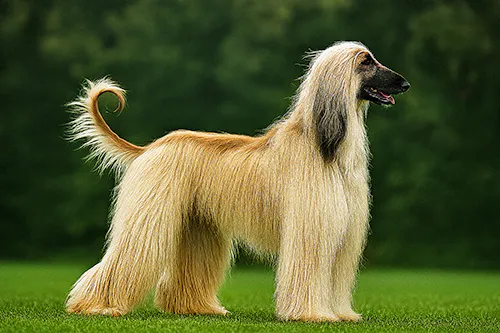
The Afghan Hound is one of the most distinctive and elegant dog breeds in the world. Known for its long, flowing coat, refined features and aloof yet affectionate nature, it has been admired for centuries both as a skilled hunter and as a companion of great beauty. Its striking profile and dignified bearing make it instantly recognisable, yet behind the glamour lies a breed with a fascinating history and specific needs.
The origins of the Afghan Hound can be traced back thousands of years to the mountainous regions of Afghanistan and surrounding areas. Bred by nomadic tribes, these dogs were valued for their ability to hunt fleet-footed game such as gazelle and hare over harsh terrain. Their speed, agility and keen eyesight made them exceptional sighthounds, able to spot and pursue prey across long distances. The breed’s long coat provided protection against the extreme cold of high altitudes, while its lean build allowed it to move with remarkable swiftness. Western travellers encountered the breed in the 19th century, and British officers stationed in the region brought some back to the UK. From there, the Afghan Hound began to appear in dog shows and gained a reputation for its exotic looks and graceful movement.
Afghan Hounds are large dogs, with males typically standing between 68 and 74 centimetres at the shoulder and females slightly smaller. Their weight usually ranges from 23 to 27 kilograms, giving them a tall yet slender frame. The breed’s most famous feature is its long, silky coat, which can come in a wide variety of colours including cream, gold, black, blue and brindle. The head is long and refined, with a narrow muzzle, dark almond-shaped eyes and long ears covered in fine hair. The tail is set low and ends in a distinctive ring curl, a hallmark of the breed.
Afghan Hounds are known for their independence. They are intelligent but can be selective in their responses to training, often preferring to think for themselves. This is a trait inherited from their hunting background, where they needed to make quick decisions without constant direction. While they can be affectionate with their families, they are often reserved with strangers and may take time to warm up to new people. Their sensitivity means they respond best to gentle, consistent handling rather than harsh correction. Afghan Hounds can live happily in a family environment, but they are generally better suited to households with no children or older children who understand how to interact respectfully with dogs.
Caring for an Afghan Hound requires commitment, particularly when it comes to grooming. Their long coat needs regular brushing, ideally several times a week, to prevent tangles and matting. Bathing is also necessary to keep the coat clean and in good condition, and drying must be thorough to avoid dampness in the undercoat. This level of grooming makes the breed high maintenance compared to many others. Exercise is equally important, as Afghan Hounds are athletic dogs that need space to run. Secure, enclosed areas are essential, as their strong prey drive can lead them to chase after moving objects without hesitation.
Afghan Hounds are generally robust but can be prone to certain conditions. Hip dysplasia, cataracts and hypothyroidism are among the issues that can occur. Like many deep-chested breeds, they can also be at risk of bloat, a serious condition that requires immediate veterinary attention. Their average lifespan is around 12 to 14 years, and with proper care they can remain active and healthy well into their senior years.
In terms of popularity, the Afghan Hound is considered rare compared to more common breeds. In the UK, it ranks far lower in registration numbers than breeds like the Labrador Retriever or Cocker Spaniel. In the United States, it is also relatively uncommon, though it enjoys a dedicated following among enthusiasts who appreciate its unique qualities. Its rarity is partly due to the grooming demands and the breed’s independent nature, which may not suit every household.
For those who are drawn to the Afghan Hound’s elegance and history, the rewards of ownership can be great. They offer companionship with a touch of regal charm, and their quiet dignity can be deeply appealing. However, they are not a breed for everyone. Prospective owners should be prepared for the grooming commitment, the need for secure exercise areas and the understanding that this is a dog with a mind of its own.
The Afghan Hound is a breed that combines beauty, history and athleticism in a way few others can match. From the mountains of Afghanistan to the show rings of the West, it has retained its distinctive character and allure. For those willing to meet its needs, the Afghan Hound offers a unique and rewarding relationship, one built on mutual respect and an appreciation for its independent spirit.
